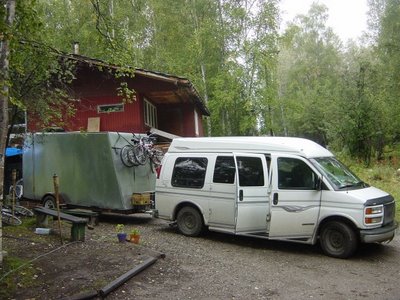Travel Log.
Saturday, Aug 26 1200 Left Fairbanks, southbound. Drizzle. Made Haines Junction about 2400. Right around a 500 mile day.
August 27 1100 After having our first taste of Canadian coffee, we departed Haines Jct. Raised Laird Hot Springs around 2330. Yet another 500 mile day :-)
August 28 Enjoyed Laird Hot Springs!! Great place. Mixed weather.
August 29 Departed 1400. Reached Dawson Creek and the end of the Alaska Highway, (1,523 miles from Fairbanks) at 0200. Stayed at Mile 0 Campground which offered great laundry and shower facilities. Wow, it would seem that the "500 mile" day is standard.
August 30 Explored Dawson Creek, provisioning and maintainance stop. Mostly sunny, wind from the northwest. Seemed like a charming little town, and the locals were a bit more friendly.
August 31 Departed 1200 under sunny skies. Encountered 15-25kt headwinds, decreasing our fuel mileage to 8.76 MPG, a new low. Raised McDonalds restauraunt, (which offers "free" wireless internet) in Quesnel (quenel) around 2000. Tonight we will stay at a Hotel, get our "free" breakfast downstairs and make a run to Tonasket, Washington (420 miles) early with minimal preparation required. We could all use a "real" berth for a night.
More pics from our travels.....


August 27 1100 After having our first taste of Canadian coffee, we departed Haines Jct. Raised Laird Hot Springs around 2330. Yet another 500 mile day :-)
August 28 Enjoyed Laird Hot Springs!! Great place. Mixed weather.
August 29 Departed 1400. Reached Dawson Creek and the end of the Alaska Highway, (1,523 miles from Fairbanks) at 0200. Stayed at Mile 0 Campground which offered great laundry and shower facilities. Wow, it would seem that the "500 mile" day is standard.
August 30 Explored Dawson Creek, provisioning and maintainance stop. Mostly sunny, wind from the northwest. Seemed like a charming little town, and the locals were a bit more friendly.
August 31 Departed 1200 under sunny skies. Encountered 15-25kt headwinds, decreasing our fuel mileage to 8.76 MPG, a new low. Raised McDonalds restauraunt, (which offers "free" wireless internet) in Quesnel (quenel) around 2000. Tonight we will stay at a Hotel, get our "free" breakfast downstairs and make a run to Tonasket, Washington (420 miles) early with minimal preparation required. We could all use a "real" berth for a night.
More pics from our travels.....

The yard sale (huge mess) we left behind..... Graciously, my brother Kraig said to leave anything we didn't sell, so we did... Thanks Kraig and crew, much appreciated!

Me, at "the sign place". Over 50,000 signs, many stolen from public works departments worldwide. Your tax dollars at work!!!
 The Traveling Rig, hour zero.
The Traveling Rig, hour zero.
 The Traveling Rig, hour zero.
The Traveling Rig, hour zero.




0 Comments:
Post a Comment
<< Home